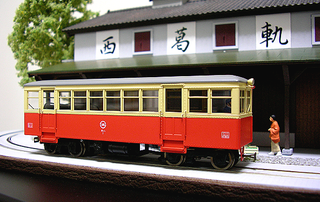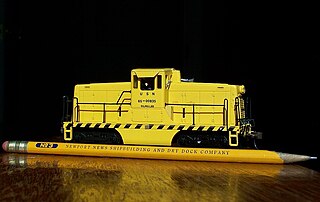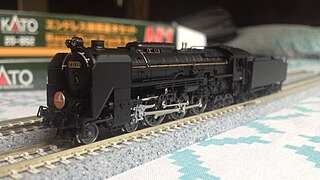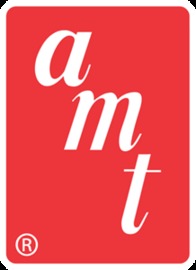
Railway modelling or model railroading is a hobby in which rail transport systems are modelled at a reduced scale.

A model car, or toy car, is a miniature representation of an automobile. Other miniature motor vehicles, such as trucks, buses, or even ATVs, etc. are often included in this general category. Because many miniature vehicles were originally aimed at children as playthings, there is no precise difference between a model car and a toy car, yet the word 'model' implies either assembly required or the accurate rendering of an actual vehicle at smaller scale. The kit building hobby became popular through the 1950s, while the collecting of miniatures by adults started to pick up momentum around 1970. Precision-detailed miniatures made specifically for adults are a significant part of the market since the mid-1980s.

HO or H0 is a rail transport modelling scale using a 1:87 scale. It is the most popular scale of model railway in the world. The rails are spaced 16.5 millimetres (0.650 in) apart for modelling 1,435 mm standard gauge tracks and trains in HO.

American Flyer is a brand of toy train and model railroad manufactured in the United States.

N scale is a popular model railway scale. Depending upon the manufacturer, the scale ranges from 1:148 to 1:160. Effectively the scale is 1:159, 9 mm to 1,435 mm, which is the width of standard gauge railway. However the scale may vary to simulate wide or narrow gauge rail. In all cases, the gauge is 9 mm or 0.354 in. The term N gauge refers to the track dimensions, but in the United Kingdom in particular British N gauge refers to a 1:148 scale with 1:160 track gauge modelling. The terms N scale and N gauge are often inaccurately used interchangeably, as scale is defined as ratio or proportion of the model, and gauge only as a distance between rails. The scale 1:148 defines the rail-to-rail gauge equal to 9 mm exactly, so when calculating the rail or track use 1:160 and for engines and car wheel base use 1:148.

TT scale is a model railroading scale using 1:120 scale with a gauge of 12 mm between the rails. It is roughly halfway between HO scale (1:87) and N scale (1:160). Its original purpose, like the name suggests, was to make a train set small enough to assemble and operate on a tabletop.

Bachmann Industries is a Bermuda-registered, Chinese-owned company, globally headquartered in Hong Kong; specialising in model railroading.

Lionel Corporation was an American toy manufacturer and holding company of retailers that had been in business for over 120 years. It was founded as an electrical novelties company. Lionel specialized in various products throughout its existence. Toy trains and model railroads were its main claim to fame. Lionel trains have been produced since 1900, and their trains drew admiration from model railroaders around the world for the solidity of their construction and the authenticity of their detail. During its peak years in the 1950s, the company sold $25 million worth of trains per year. In 2006, Lionel's electric train became the first electric toy inducted into the National Toy Hall of Fame. In 1969, they sold their model train lines to General Mills, but continued to operate until 1993 as a holding company for their toy stores. Its model trains are still in production as a separate company.

Revell GmbH is an American-origin manufacturer of plastic scale models, currently based in Bünde. The original Revell company merged with Monogram in 1986, becoming "Revell-Monogram". The business operated until 2007, when American Revell was purchased by Hobbico, while the German subsidiary "Revell Plastics GmbH" had separated from the American firm in 2006 until Hobbico purchased it as well, in 2012 –bringing the two back together again under the same company umbrella. After the Hobbico demise in 2018, Quantum Capital Partners (QCP) acquired Revell

The Consolidation Line was a series of diesel-electric railway locomotive designs produced by Fairbanks-Morse and its Canadian licensee, the Canadian Locomotive Company. Railfans have dubbed these locomotives “C-liners”, however F-M referred to the models collectively as the C-Line. A combined total of 165 units were produced by F-M and the CLC between 1950 and 1955.
Tyco Toys was an American toy manufacturer. It was acquired by Mattel in 1997.

Athearn is a United States manufacturer of model railroad equipment, produced and distributed by American hobby manufacturer Horizon Hobby, Inc. of Champaign, Illinois.

Lego Trains is a product range and theme of the construction toy Lego, which incorporates buildable train sets. The Lego Trains theme became a sub-theme of Lego City in 2006. Products in the range have included locomotives, tracks, rolling stock, stations, signal boxes, and other track-side buildings and accessories. The theme is popular among adult fans, as well as children, and has spawned international associations and conventions. The train system is sometimes referred to as 'L-gauge' among Lego fans, in reference to traditional model railway scales. Lego trains use a nominal gauge of 37.5 mm, based on 5-stud track centerlines gauge, corresponding with a circa 1:38 scale.

Wm. K. Walthers, Inc. is a manufacturer and distributor of model railroad supplies and tools.

Life-Like was a manufacturer of model trains and accessories. In 1960, the company purchased the assets of the defunct Varney Scale Models and began manufacturing model trains and accessories under the name Life-Like in 1970. In 2005 the parent company, Lifoam Industries, LLC, chose to concentrate on their core products and sold their model railroad operations to hobby distributor Wm. K. Walthers. Today, the Life-Like trademark is used by Walthers for HO Scale Buildings.

Atlas Model Railroad Company, Inc. makes scale models in N scale, HO scale, and O scale. The company is based in Hillside, New Jersey, United States. They produce a wide variety of locomotives, rolling stock, and vehicles. Atlas is well known for their flex track and codes 55, 80, 83 and 100 track. Atlas also produces a line of compatible structures and bridges.

Kato Precision Railroad Models is a Japanese manufacturer of model railroad equipment in N and HO scales. Founded in 1957, the Tokyo-based company manufactures models based on Japanese prototypes for the Japanese market, North American prototypes for the North American market and European high-speed trains for European market. The design and distribution of models for the North American market are handled by their U.S. subsidiary, Kato USA, founded in 1986 and located in Schaumburg, Illinois.

Aluminum Model Toys (AMT) is a toy manufacturing brand founded in Troy, Michigan, in 1948 by West Gallogly Sr. AMT became known for manufacturing 1/25 scale plastic automobile dealer promotional model cars and friction motor models, and pioneered the annual 3-in-1 model kit buildable in stock, custom, or hot-rod versions. The company made a two-way deal in 1966 with Desilu Productions to produce a line of Star Trek models and to produce a 3/4 scale exterior and interior filming set of the Galileo shuttlecraft. It was also known for producing model trucks and movie and TV vehicles.

Brass models, made of brass or similar alloys, are scale models typically of railroad equipment, bridges and occasionally, of buildings. Although die-cast or plastic models have made considerable advances in late 1990s and continue to improve, brass models offer finer details. Brass models, considered to be collector's pieces and museum quality finish, are often used for display purposes rather than model railroad operations. However, these can be made fully operational and many railroaders do use them on their model railroads. They are generally considerably more expensive than other types of models due to limited production quantities and the "handmade" nature of the product itself.
Bowser Manufacturing is a United States manufacturer of model railroad equipment, located in Montoursville, Pennsylvania. Founded in 1946 by Bill Bowser in Redlands, California, he used his skill as a machinist to design and produce one of the first lines of accurately scaled steam locomotive kits in HO scale. In 1955, his financial partner Donald Acheson forced Bowser out of the company by enforcing a buyout clause in their agreement. After Acheson sold the considerable backstock of kits and parts, he sold the company to Lewis English in 1961. The company has since grown and continues to produce its own line of injection molded plastic model kits and ready-to-run locomotives.

















